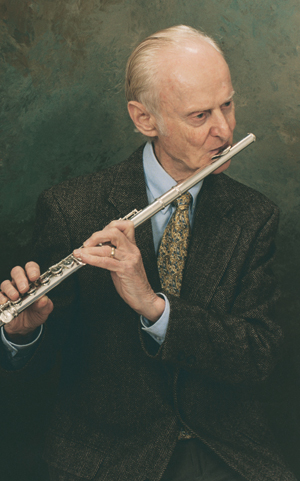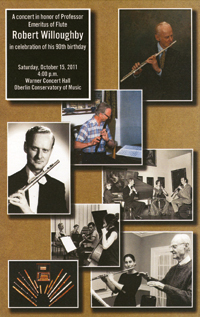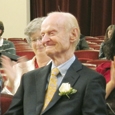.jpg)
Robert Willoughby, Oberlin Professor Emeritus of Flute, was honored by Oberlin College and former students on the celebration of his 90th birthday. About 100 family and friends gathered in Warner Concert Hall for an afternoon concert of traverso and flute music performed by 12 of his former students, all of whom are outstanding performers and teachers. I was fortunate to spend a few minutes with Robert Willoughby and his wife Mac discussing his views on flute playing and teaching.
Who were your teachers?
After my 2nd and 3rd years at Eastman with Joseph Mariano I attended Tanglewood. I had heard the Boston Symphony Orchestra in Rochester and had fallen in love with Georges Laurent’s sound. I was in the service for two and a half years and then went to Boston to study. Later when I was playing in the Cleveland Orchestra I worked summers in a New Hampshire resort hotel. Kincaid was in Maine teaching, so I went to him for occasional lessons for three summers.
In one of the early lessons, Kincaid put forth an idea. I asked him to explain it more thoroughly. He thought I was questioning him and really got huffy. I explained that I just wanted to understand so I could teach it. After my explanation, he was fine, and I could ask him anything. He did not like to be questioned. He and Tabuteau (Philadelphia Orchestra Principal Oboe and Oboe professor at Curtis) were almost like gods. If you didn’t shape up, you were out.
 How did you build your technique?
How did you build your technique? One summer after my first year in college I worked through a whole bunch of Marcel Moyse books. Then after I got out of the service and was in graduate school, I changed my focus. In undergraduate studies, I focused on course work and then practiced. In my graduate studies, I focused first on flute practice. I practiced four to five hours a day and accomplished so much because I could hone in on it. I think at some point you need to take a year off and just work on technique.
I play in church every couple of months. I usually do a slow and a fast number. I am killing myself on the slow one, but everyone thinks it is the fast one that is difficult.
Did you enjoy the Moyse books more than the Taffanel?
Oh no, it doesn’t matter. The thing about the Moyse books is that they are very methodical. Of course, there are a 100 different ways to approach building a technique. Have you ever noticed that non-musicians think they would like to hear you practice, but after five minutes, they creep out of the room? They want to hear melodies.
When listening to a flutist play, I can always pick out a Willoughby student. They have a concern for tone especially in using colors and in the connection of the notes.
Yes, I have worked hard on that. To teach students to seamlessly connect the intervals is very simple. I don’t claim some of the ideas I may tell you this morning are necessarily original. I don’t think there is such a thing as an original idea anyway. So, if I say something you have read in a book somewhere else before, it is because you have probably read the same book.
To play a perfect fifth, I simply have them start with a chromatic scale filling in the interval of a perfect fifth. Then fill the interval by playing the major scale, then in thirds and finally the interval itself. I usually have them make a diminuendo as they go up partly for balance purposes. Then turn around and crescendo on the way down. I also have students listen to singers. Singers don’t go ah, ah, ah. There is a feeling of glissando [in the line]. I think you have to get it in your ear. Flutists also often don’t get the feeling of intensity as they climb up the phrase as they don’t quicken the pace enough between the phrases.
What are your thoughts on the corners down embouchure?
The corners down can be helpful. I am sort of a combination. Mariano and Laurent couldn’t have been more different. Kincaid was in the direction of Mariano but had a different outlook on life. Kincaid could analyze things in a way that I don’t think the other two could, so I like something sort of in between the two schools of thought. I have had some students who go out sounding very French, and others the opposite. Do whatever works.
I think you can focus the sound with your lips. I like to do what I call the rabbit thing, where you whew, whew, as you lift the upper lip like a rabbit. I think the tone should have focus. I am not a devotee of the extreme Mariano or Kincaid sound, which was very open. I prefer more center to the sound. I prefer the Laurent sound. The sound should have purity and elegance.
When students have a tight embouchure, I have them practice the overtone series and whistle tones (start with an easy fundamental note, such as the third-spaced C). I do think the Mariano concept of puffing the cheeks to open up when playing high is good. I often wondered if the huge sound Mariano got was the result of playing for conductor Jose Iturbi. Iturbi could get never get enough sound, and Mariano said, I can give you sound.
Do you teach the “p” or “b” attack?
I like to concentrate on the tongue-less attacks. [Often called breath attacks or throat staccato.] Get the center of the tone with the whistle tone, and then go into the breath attack. With the air, produce a sound with resonance.
 What about articulation?
What about articulation? Well, in particular, if you play Baroque music, you should soften up the attacks. You cannot do a sharp tongue because it doesn’t work on the Baroque flute. You should take that aspect from Baroque flute and apply it to the silver flute. I don’t really do [articulate] between the teeth. I stay back but not too far. I think you have to find what works for you. I like a sharp attack. Lots of times I start without the tongue, just blowing, like for the opening of Debussy’s Afternoon of a Faun. It is the perfect place to do it, to suddenly just be there.
When I first studied Baroque flute, I was learning about the style. It is not enough to play the flute for the style; you have to learn how to be someone of this period. Read about the people. The size of the rooms they performed in was so different from today.
What are your thoughts about vibrato?
I have very strong feelings about vibrato. Many people don’t vibrate on each and every note. When students have a quarter followed by two 8ths, I have them play straight (non-vibrato) on the quarter and then vibrate on the two 8ths. I have another exercise for students who have trouble vibrating the short notes. I ask them to vibrate a long note and then repeat this note making it shorter each time until they can vibrate a short note. I work with my students on conducting a slow beat in 44. The downbeats are almost always the strongest note. I have them fill in the spaces between the beats using a relaxed wrist. They also watch ballet dancers for the continuous fluid motion. It is very useful to notice how they use their bodies. It is like being on the edge of a cliff. If you don’t have balance, you will fall off.
Any suggestions about breathing?
Breathing: good idea! I think Pavarotti found a wonderful way to breathe and support. The thing I like about his singing is it is so effortless, but he is putting a lot of energy into it and it is coming from down here. When he breathes in, he relaxes and lets the air in.
What literature do you start on with new students?
It depends. I have them bring in what they have to see where they are. Then I give them something fairly simple like the Faure Morceau de Concours so we can work on simple concepts. I worry about those who bring in the Prokofiev Sonata before they are ready. Opera singers are smart. They often say, “I am not ready for that role. I am only 45, I am not mature enough.” Pianists do that too.
After you have taught a flutist for a while, what literature do you teach?
Bach, of course. With graduate students, I like to go through all the Telemann Fantaisies because they are simple, and the concepts you find there can apply to all music.
How do you think the flute should be aligned?
Do what fits you. I do it almost without thinking. I just put the flute where it is comfortable. The position of the embouchure plate on the lip depends on the person. Some have full lips, and others thin. I don’t think there is any one particular way that works for everybody. This is, in general, my philosophy about flute playing. The main thing is to not play it the same way all the time and know where you are going. Have a focal point in your phrase. Why do flutists heavily vibrate the last note of a phrase, whah, whah, whah, when the last note is the least important note of the phrase? I call this the Metropolitan Opera way of vibrating. Of course, singers do it for a reason, projection, as the Met has 5,000 seats.
Where should the flutist stand when playing with piano?
I think it is helpful to have them experiment with different placements, because I don’t think it is necessarily best to be in the crook of a piano. For example, if a flutist doesn’t have a big sound and is performing the Prokofiev Sonata, the flutist may achieve a better separation and projection if standing where a violinist would stand. The same thing is true when performing with the harpsichord. Experiment.
Do you mind if your students take lessons with someone else while studying with you?
I never have had a problem with my students studying with someone else. In the case of one student at Oberlin, he and I butted heads for a whole year. By the end of the year, I thought to myself, I am not sure I can handle this. So when fall came I decided that I was not going to bug him. If he took my advice, fine; if not, fine. However he had studied with someone else over the summer, and this teacher told him the same things I had said. Suddenly it made sense and he began to listen.
Additional comments from Willoughby’s students below:
Mr. Willoughby (now unbelievably my colleague Bob) gave me so much in those formative years: a refinement of sound, consistent, always with perfection of intonation as the goal, equally with flexibility and adaptability. How could my young years and ears be ready for such a level of mastery? And let’s not leave out how he settled for nothing less than brilliant virtuosity. All those etudes. It seemed as though it would never stop. I constantly asked myself when would I get to the real stuff, the real repertoire? Patient beyond measure, never compromising his standards, encouraging calmly and assuredly, guiding and directing, open to all my ideas as well, tough and sensitive altogether, a subtle and warm sense of humor, so knowledgeable about the developing player.
– Carol Wincenc
It took years of my own teaching before I could realize what a challenge Bob had faced with me as a student, in terms of tight embouchure and high level of residual tension in my playing. Other teachers would say “relax!” but Bob developed tools and concrete practical methods that produced results the others couldn’t get. Decades later, I still begin every practice session, and every lesson I give, with tongue-less attacks. – Patricia Spencer
We don’t want dessert for breakfast, lunch and dinner, our Teacher exclaimed if one used too much of the same vibrato and emphasis. He disliked redundancy. – Mark Sparks
I recall some very helpful comments and exercises that revolutionized my playing: Bob was very insistent on seamless phrasing. One simple maxim: always begin a phrase (or note after a breath) in the same dynamic as where you left it. Don’t come crashing in forte where you just left off piano.
For a relaxed embouchure: practice transitioning from a whistle tone into a full tone and back without changing your embouchure. Practice this in front of a mirror.
– Robin (Poor) Etter
My favorite Willoughby quote: “I find I never run out of air if I’m always breathing.” – Tim Day
Robert Willoughby was the single most influential teacher/artist of my career. – Victoria Jicha, Editor Emeritus, Flute Talk Magazine
Mr. Willoughby told me during a lesson my sophomore year, as I cried that I would NEVER be able to play these orchestral excerpts, "You may get a win a job on your first audition, or on your 100th. Just keep taking them." I won a job on my 2nd audition, and on my 3rd audition, and again, on my 15th. I repeat his words to my daughter, and to my son, both musicians, who will be in the world of competitive musicianing. – Robin McKee, class of ’76
I arrived at college with a tight, smile embouchure. Mr. Willoughby in his gentle way led me through an embouchure change. I who was used to playing concertos had to go back to long-tones and painstaking work to remake my embouchure in a way which utilized my oral cavity to enhance the sound. This has been my basis for finding a ringing sound ever since. So– thank you Mr. Willoughby! – Julia Bogorad-Kogan
The exercise most helpful to me in developing my vibrato was the tongue-less attacks. This strengthens the diaphragm muscles and ensures that it is the basis for the support of your tone. The speed and variation of the vibrato is controlled from here. Thank you Bob for being my great teacher and friend. – Paul Horn ’52
Everything about lessons with Robert Willoughby reflected how seriously he took his responsibility as a teacher. It was clear that his goal was not simply improvement or the ability to win an audition. He wanted us each to graduate with all the tools necessary to face any future musical challenge. In other words, when we left Oberlin he expected us to have the ability to teach ourselves and to keep growing. – Mary Kay Fink
When I think of Bob Willoughby I think of a man who not only teaches and plays the flute with beauty, but who is a person of high integrity, authenticity and honesty. I am truly fortunate to have been your student ever since my days at Oberlin. – Ann (Kozuch) Fairbanks
It has taken a long time for me to distill what you have taught me since those lessons in September, 1949, at Oberlin: You helped me to organize and build a fine “warm-up” schedule to advance my finger technique and to create a fine sound. You worked continuously to help me create better musicianship in order to interpret the various styles of musical composition. You taught me, by example, how to organize a recital by diversifying styles. You taught me to keep learning new techniques and expanding repertoire! Thank you for your intelligent, fair, honest comments about my playing and for being such a fine role model for professional behavior in an orchestra, on stage, and on a faculty. I was most fortunate to have you as an undergraduate and graduate teacher for six years—and later on as a colleague at the Peabody Institute of Music when you retired from Oberlin. Thanks to you I was able to sustain a long career (and MANY conductors). – Bonnie J. Lake
As I became recognized for my piccolo playing in New York City, I used that chromatic tuner daily. You motivated me to practice all my warm-ups while watching the dials, to see that I maintained the same number of partials in each note and always remained in tune. Yes, I blame you for making me slightly crazy, but I also credit you for giving me the tools to improve my playing and maintain a truly successful career. – Florence Nelson






